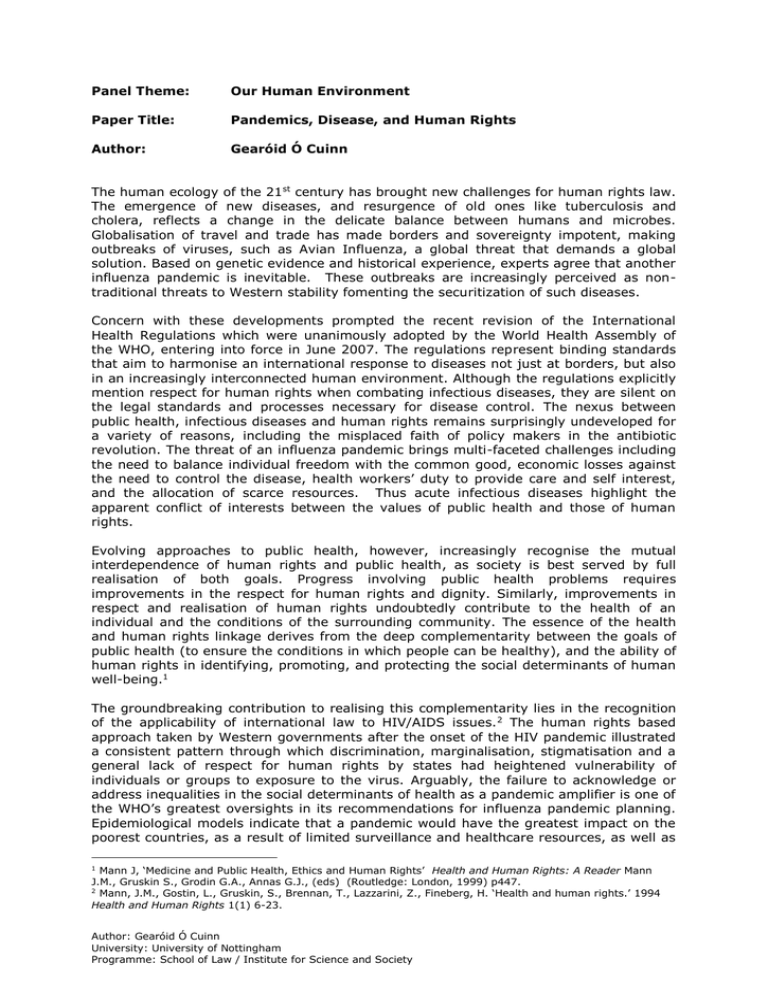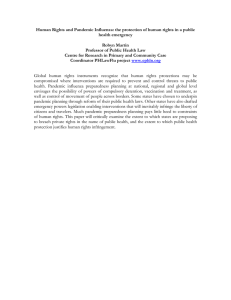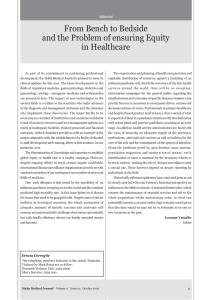Pandemics, Disease and Human Rights
advertisement

Panel Theme: Our Human Environment Paper Title: Pandemics, Disease, and Human Rights Author: Gearóid Ó Cuinn The human ecology of the 21st century has brought new challenges for human rights law. The emergence of new diseases, and resurgence of old ones like tuberculosis and cholera, reflects a change in the delicate balance between humans and microbes. Globalisation of travel and trade has made borders and sovereignty impotent, making outbreaks of viruses, such as Avian Influenza, a global threat that demands a global solution. Based on genetic evidence and historical experience, experts agree that another influenza pandemic is inevitable. These outbreaks are increasingly perceived as nontraditional threats to Western stability fomenting the securitization of such diseases. Concern with these developments prompted the recent revision of the International Health Regulations which were unanimously adopted by the World Health Assembly of the WHO, entering into force in June 2007. The regulations represent binding standards that aim to harmonise an international response to diseases not just at borders, but also in an increasingly interconnected human environment. Although the regulations explicitly mention respect for human rights when combating infectious diseases, they are silent on the legal standards and processes necessary for disease control. The nexus between public health, infectious diseases and human rights remains surprisingly undeveloped for a variety of reasons, including the misplaced faith of policy makers in the antibiotic revolution. The threat of an influenza pandemic brings multi-faceted challenges including the need to balance individual freedom with the common good, economic losses against the need to control the disease, health workers’ duty to provide care and self interest, and the allocation of scarce resources. Thus acute infectious diseases highlight the apparent conflict of interests between the values of public health and those of human rights. Evolving approaches to public health, however, increasingly recognise the mutual interdependence of human rights and public health, as society is best served by full realisation of both goals. Progress involving public health problems requires improvements in the respect for human rights and dignity. Similarly, improvements in respect and realisation of human rights undoubtedly contribute to the health of an individual and the conditions of the surrounding community. The essence of the health and human rights linkage derives from the deep complementarity between the goals of public health (to ensure the conditions in which people can be healthy), and the ability of human rights in identifying, promoting, and protecting the social determinants of human well-being.1 The groundbreaking contribution to realising this complementarity lies in the recognition of the applicability of international law to HIV/AIDS issues. 2 The human rights based approach taken by Western governments after the onset of the HIV pandemic illustrated a consistent pattern through which discrimination, marginalisation, stigmatisation and a general lack of respect for human rights by states had heightened vulnerability of individuals or groups to exposure to the virus. Arguably, the failure to acknowledge or address inequalities in the social determinants of health as a pandemic amplifier is one of the WHO’s greatest oversights in its recommendations for influenza pandemic planning. Epidemiological models indicate that a pandemic would have the greatest impact on the poorest countries, as a result of limited surveillance and healthcare resources, as well as Mann J, ‘Medicine and Public Health, Ethics and Human Rights’ Health and Human Rights: A Reader Mann J.M., Gruskin S., Grodin G.A., Annas G.J., (eds) (Routledge: London, 1999) p447. 2 Mann, J.M., Gostin, L., Gruskin, S., Brennan, T., Lazzarini, Z., Fineberg, H. ‘Health and human rights.’ 1994 Health and Human Rights 1(1) 6-23. 1 Author: Gearóid Ó Cuinn University: University of Nottingham Programme: School of Law / Institute for Science and Society the general poor health and nutritional status of the population. 3 As stated in Art. 12.2 (c) of the ICESCR, a proper response requires “the establishment of prevention and education programmes for behaviour-related health concerns … and the promotion of social determinants of good health, such as environmental safety, education, economic development and gender equity”. An overly individualistic, or medicalised approach to health masks the actual processes that shape our microbial environment and promotes a pharmacological solution, an approach hampered by global inequalities. Although adaptive genetic dynamics of infectious diseases play an important role in generating disease burdens, factors under human control play an even larger role in heightening the risk of disease outbreaks.4 Diseases evolve when humans intensively interact with the natural environment, urbanisation generates overcrowding and invariably a reduction in environmental health. In the developing world this is compounded by human induced movements of poultry. Unsanitary conditions and close quarter live animal markets facilitate millions of potential cross-infections for respiratory diseases. To prevent or mitigate the impact of respiratory disease outbreaks, this ecosystem should considered as part of the environmental front, complementing the human medical and research response. It is proposed that a more socialised and environmentally informed view of human rights is required to recognise the determinants of health relevant to outbreaks of acute diseases, such as Avian Influenza and to properly guide states as a global ethical framework for pandemic policy. WHO 2004: Informal consultation on influenza pandemic preparedness in countries with limited resources. Kuala Lumpur, Malaysia 23.25 June 2004. Department of Communicable Disease Surveillance and Response. http://www.who.int/csr/resources/publications/influenza/WHO_CDS_CSR_GIP_2004_1/en/index.html. 4 Nicastri E, Girardi E, Ippolito G. ‘Determinants of emerging and re-emerging infectious diseases.’ 2001 J Biol Regul Homeost Agents. 15(3) 212-7; Urbanization for example brings with it the problems of housing, sanitation, pollution, drinking water, and health care facilities. Increasing population densities and urban poverty encourage the spread of viruses. 3 Author: Gearóid Ó Cuinn University: University of Nottingham Programme: School of Law / Institute for Science and Society



